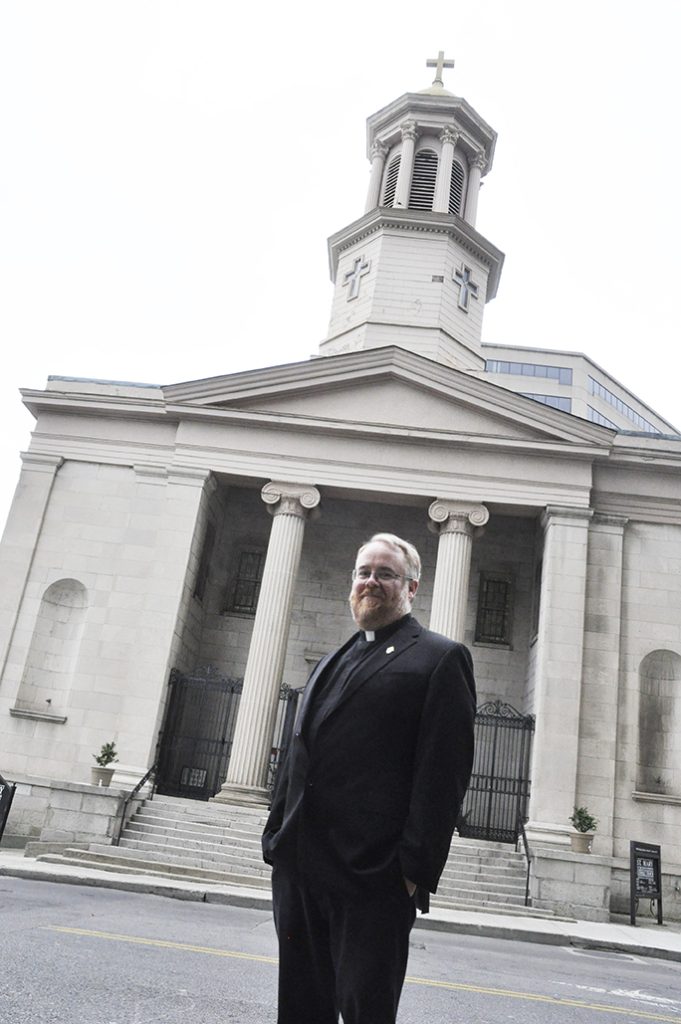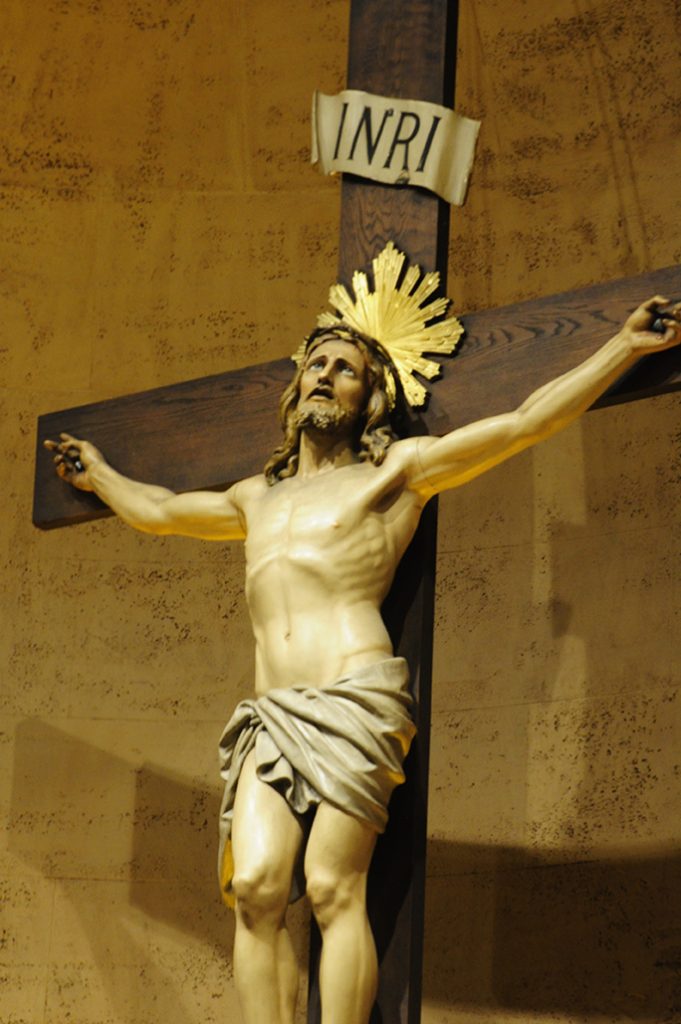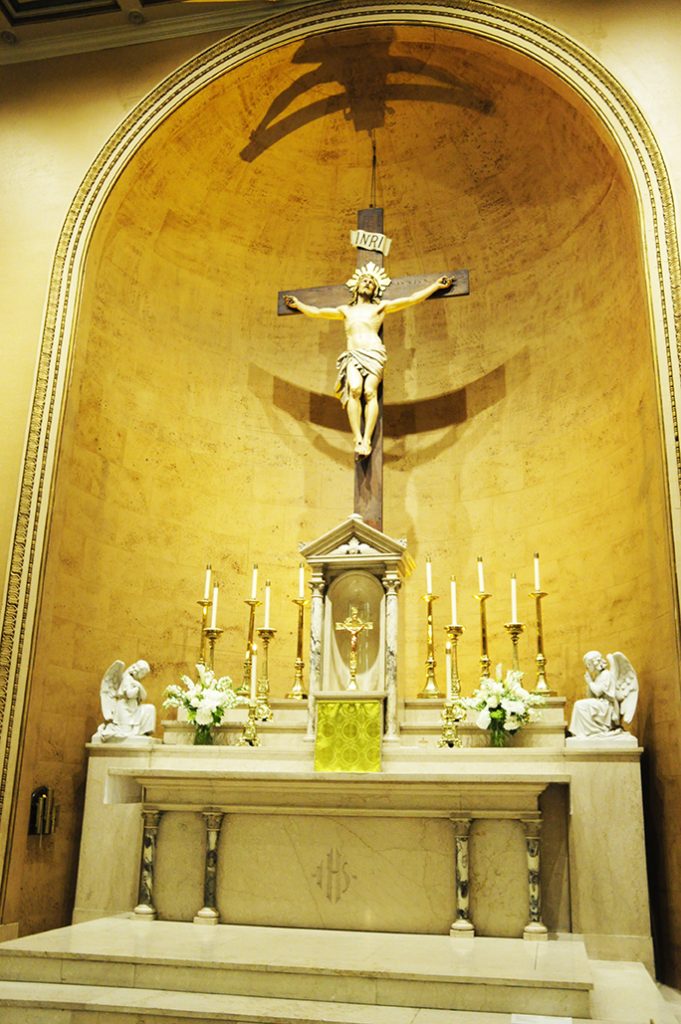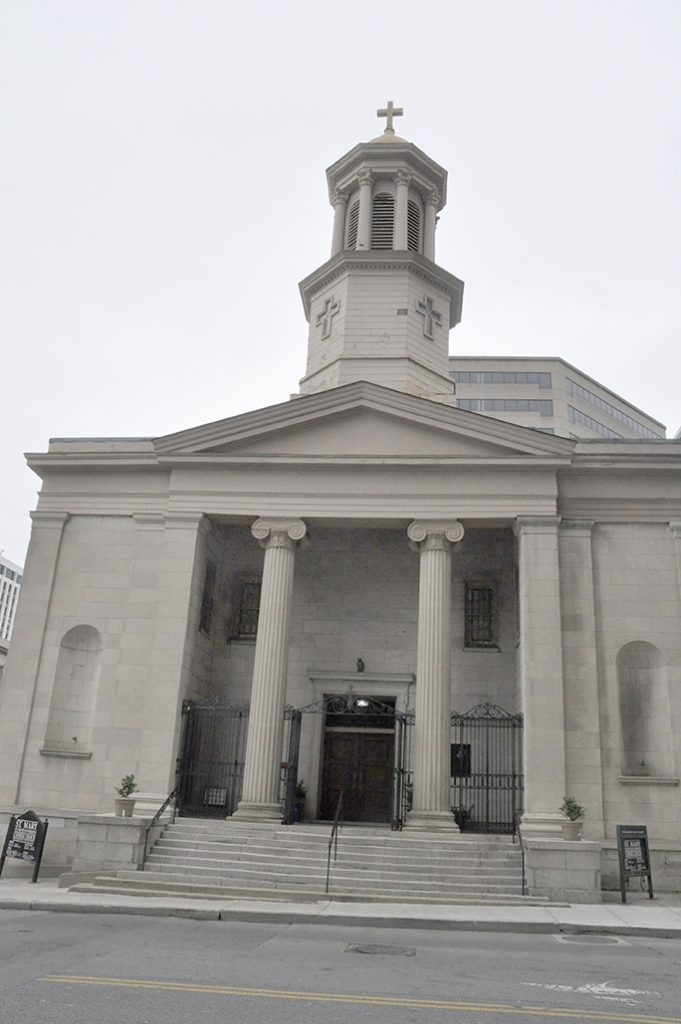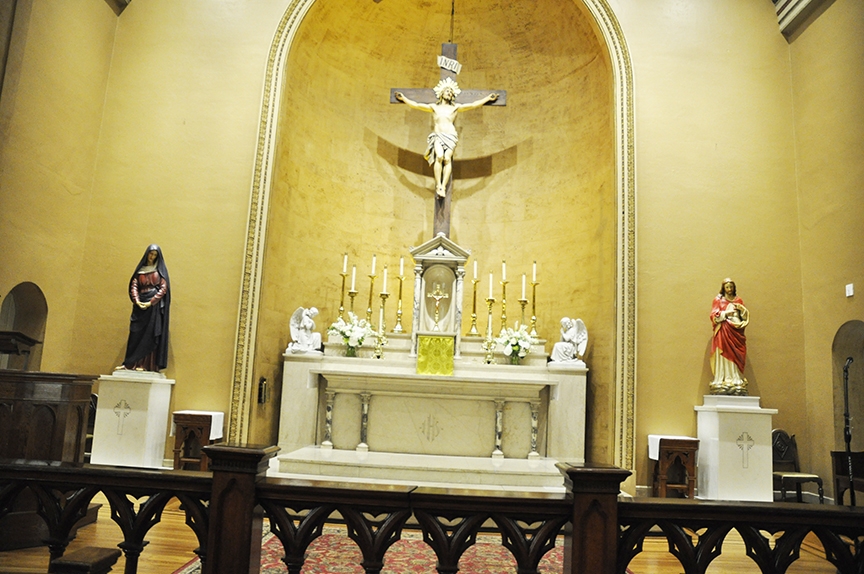
From the heart of war to heartfelt celebrations and everything in between, it all tells the story of St. Mary of the Seven Sorrows Church in downtown Nashville as it prepares to celebrate its 175th anniversary with a special Mass at 7 p.m. Tuesday, Nov. 1.
The Mass will be celebrated by Father Jayd Neely, pastor of St. Mary, with Bishop J. Mark Spalding serving as the homilist.
“It’s an honor to be the pastor here during this historic event in the life of the parish,” Father Neely said. “We’re trying to carry on that tradition and legacy which was handed down to us by the bishops, priests, and parishioners who have gone before us.”
The Mass will feature the traditional customs that date back from the time of St. Mary’s founding and which continue today, such as the use of Gregorian chant and English hymns from the 19th century.
“It’s a treasure being able to do the high level of liturgical music we can do here,” said Dr. Nancy Sutton, who has served as music director and organist for St. Mary for the past seven years. “It’s spiritually moving to hear Gregorian chant sung by the Schola and the congregation singing traditional English hymns.”
The History of St. Mary
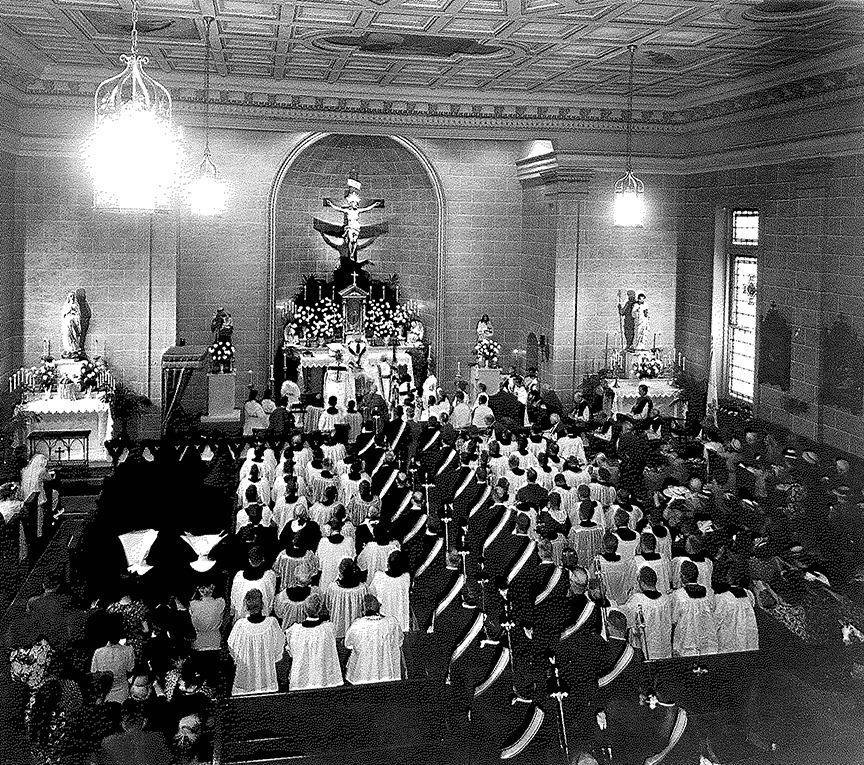
St. Mary’s story begins in the mid-1800s, when Bishop Richard Pius Miles, the first bishop of the Diocese of Nashville, purchased land on the corner of Cedar and Summer Streets, now Fifth and Charlotte Avenues, on March 30, 1844. The spot, considered to be the heart of Nashville, was just down the hill from where the State Capitol was being built, the former site of the first cathedral of Nashville, Holy Rosary Church. That land was offered to the state in 1843.
The cornerstone of the new church, which would become the second cathedral of Nashville, was subsequently laid on the Feast of Corpus Christi, June 6, 1844.
“This is the first time that a Mitre and Crozier have been seen in the streets of Nashville, and they must have produced strange feelings in many,” Bishop Miles wrote of the occasion.
Three years later, the new cathedral under the name and patronage of the Blessed Virgin of the Seven Dolors was completed and dedicated on Oct. 31, 1847. From the time of its dedication until the current Cathedral of the Incarnation on West End was completed in 1914, St. Mary served as the seat of the first five bishops of Nashville – Bishop Miles, Bishop James Whelan, Bishop Patrick Augustine Feehan, Bishop Joseph Rademacher and Bishop Thomas Sebastian Byrne.
Upon his death in February 1860, Bishop Miles was interred under the altar of St. Mary where it remained until 1972 when it was disentombed during renovations. Reports have said that the body was found to be incorrupt. The casket was later reinterred in a smaller chapel within St. Mary where it remains to this day.
Although it no longer remained the home of the bishop’s seat, and its number of parishioners has wavered at times, St. Mary remains the oldest continuously active Catholic church in the city of Nashville, having only briefly ceased Masses so it could be converted into a hospital for Union and Confederate soldiers during the Civil War’s Battle of Nashville in December of 1864. After that service ceased in January of the next year, the church underwent the first of very few renovations over the years to bring it back to its initial state.
The only other major renovations done in its history were when electricity was installed under the tenure of Bishop Byrne, and then later under the leadership of Father Edward P. Desmond who was appointed pastor of St. Mary by Bishop Alphonse J. Smith, the sixth bishop of Nashville, in the early 1900s. Renovations included putting in new bricks on the side of the church and “finishing off the façade with the pressed stone-bit blocks that are there today,” according to “The Catholic Church in Tennessee: The Sesquicentennial Story” written by Thomas Stritch in 1987. Father Desmond also added cast iron gates and fences, installed a new altar, cleaned the interior and brightened it up, and more.
Since the remodel by Father Desmond, only minor changes have been made, such as new lighting and multiple replacements of the floor. Under the tenure of Bishop David Choby, the 11th bishop of Nashville, the ceiling was professionally redone and the pews were refurbished in the mid-2010s. That renovation also included shoring being inserted in the attic for structural integrity. Due to various events repairs have had to be made, too. In 1998, repairs were made to the church after it received minor damage from a tornado that hit Nashville in April of that year. Additionally, repairs were made to some windows following the Christmas Day bombing in downtown Nashville in December of 2020.
But even with the changes and repairs, the church has maintained its traditional Grecian-architectural style and is one of the few churches in the Diocese of Nashville today that continues to implement traditional styles of worship such as using communion rails during the distribution of the Eucharist to parishioners, celebrating Mass ad orientem with the priest facing east rather than the congregation, regularly including Latin, and using traditional English hymns and Gregorian chants.
Tradition leads to conversion
It’s this consistency of tradition that parishioners, both young and old, have said led to them choosing St. Mary as their home parish.
“I lean towards the traditional and I missed it,” said Pamela Williams, referring to when her family moved to Nashville 20 years ago from Virginia where she was a parishioner of a traditional Latin Mass chapel. For the first three years, unaware of any traditional Mass options in the area, Williams and her family attended St. Matthew Church in Franklin. But then, in 2005, while looking up something in the phone book, she said an ad caught her eye.
“There was a little ad for St. Mary that said they did Mass in Latin once a month. That immediately attracted me. Then, it mentioned it was the oldest church in Nashville, and I knew I wanted to go see it,” Williams said. “We walked in, and it was just so beautiful. You could just smell how the incense had permeated the walls over the years.
“St Mary connects us with the past and helps us know where we came from, and the way things were done for so many years,” she added. “Although it’s not completely the traditional Mass anymore, there are the traditional elements there like the regular use of incense and the communion rail.”
And she credits the significant history of St. Mary as well as the interest in that history by its most recent pastors, particularly Father James Norman Miller, leading to her husband Mark’s current participation in the Rite of Christian Initiation for Adults to become a Catholic.
“Mark hit it off with Father Miller, who loved talking about the history of the church and how during the Civil War, they closed it down and used it as a hospital,” Williams explained. “After many, many years of sitting there, I think the Holy Spirit has finally worked on Mark, and I do wonder if it hadn’t been for the history of the building and the priest that was there when we first started if he would have gotten to this point.”
Pam Christy, who has been a parishioner of St. Mary for 25 years, also noted the Latin Mass as a reason for her eventually joining the parish. A native of Nashville, Christy grew up attending Holy Name Church and St. Joseph School in Madison, from which she graduated in 1981. Later, she began attending the Cathedral of the Incarnation while she was a student at St. Cecilia Academy, from which she graduated in 1985.
But then she started attending the Latin Mass at St. Mary each month and got to know the history of the church.
“Being interested in history, I loved hearing Father Miller tell the history and many stories of the church,” Christy said. “His passion for St. Mary made me want to become a member of the parish,” and she officially joined in 1997.
“I particularly enjoy The Solemn Mass offered on Sunday morning,” she said. “I can feel the tradition and history there, and I see families attending with the parents teaching their small children to be respectful and love Our Lady.”
A St. Mary love story
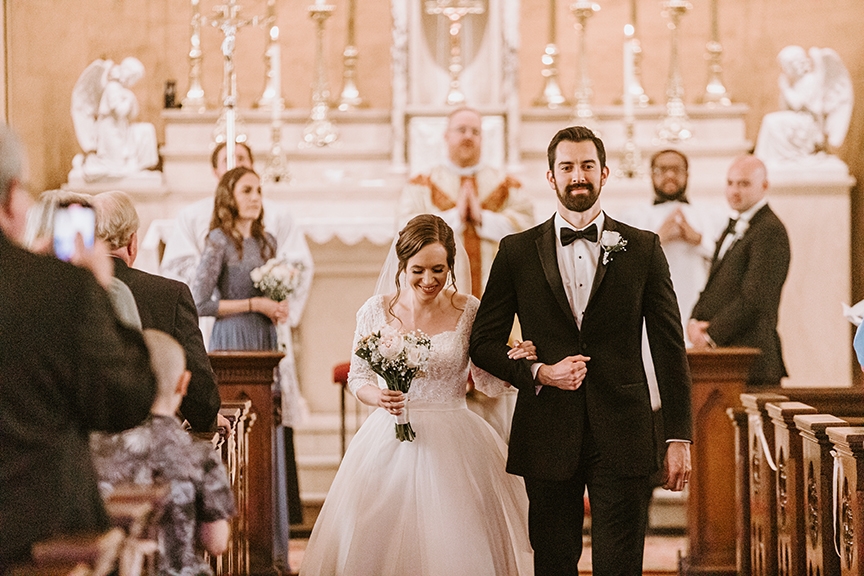
After Father Miller’s 30-year tenure ended with his retirement in 2012 and Father John Sims Baker was installed as pastor, Williams said the parish community grew as young adults and families began coming to the parish, largely in thanks to Father Baker’s dual role as chaplain of University Catholic at the time.
One of those new young parishioners was Maude Green, who grew up a cradle Catholic, attending the Cathedral of the Incarnation with her family. But St. Mary was not new to her when she joined in 2014, having played violin on occasion because of a family friend who was part of the music program there.
“It’s really interesting seeing old pictures (of St. Mary) and just seeing how the surroundings have changed,” said Green, who is a 2004 graduate of St. Bernard Academy and a 2008 graduate of Pope John Paul II Preparatory School. “Just going into St. Mary, you think about all the people who have been there before you through all the different historical events … and it reminds you that people have been celebrating Mass there for so long through all the changes and growth of Nashville, and it just really makes you think.”
Meanwhile, Dustin Shane, who grew up a Jehovah’s Witness before converting to Catholicism in 2010, was on his own journey to St. Mary. Following his conversion, he attended St. Ann Church before spending a few years in the military and even as a seminarian for the diocese before ultimately discerning out. Although he hadn’t yet joined St. Mary as a parishioner, he had attended a few Masses and enjoyed the traditional style of the Mass.
“It’s like the whole church and the Mass and everything just fit,” Shane said. “It’s the oldest continuous church in the city, and you can feel that, especially in the fact that the first bishop is buried in the church. … You just feel the history of this is the birthplace of Tennessee Catholicism.
“The liturgy and the way we celebrate Mass just fits and matches that from the Gregorian chants, beautiful English hymns and so forth,” he said. “Then, the Catholic Church is the oldest church in history and was founded by Our Lord. Being in an old church makes you feel that more; it makes you feel those roots more.”
This shared love of the tradition at St. Mary is what connected the two young Catholics from the very moment they met during a Christmas party in December 2017.
“St. Mary was one of the first things we talked about,” Shane said, when Green mentioned that it was her parish during that first conversation. “So then I started going since she went there.”
“It was the first thing we connected over,” she added.
Two and a half years later, Green and Shane were married at St. Mary on June 13, 2020.
“It was just so beautiful. I remember, I felt like the church raised us. We were like the children of the parish because it was the birth of our relationship,” Maude Shane said. “Father Neely, (who came on as pastor in 2016), was so supportive from the beginning. He was so wonderful.”
“I feel like the parish was rooting for us,” Dustin Shane added. “Most of the couples are a little bit older than us, so they’d seen us both through our years of dating and saw our relationship grow, and they all seemed very invested in us. It really felt like a community.”
Now, they are passing on the roots of their relationship to their growing family in their 1-year-old son, Mark.
Its reputation precedes itself
St. Mary’s long history and traditional ways weren’t just known within the boundaries of the diocese but all over and is what brought Marie Strickland to the parish when she moved for work two years ago from Wilmington, North Carolina, upon completing her master’s degree in business analytics.
“I had heard about St. Mary before I moved, and I knew it was more traditional,” Strickland said. “I grew up at a church in Charlotte that was very traditional and reverent, so that’s what I was looking for in a church in Nashville.”
“St. Mary has the ad orientem Mass, which I thought was beautiful, and I just love the old feeling of it,” she said. “You walk in, and you know that it’s been here for a while.
“It’s really awesome to be part of something so historical. I’ve met parishioners that have said their families have attended for generations,” she said, “and now I’m part of that family, too.”
